Sensitivity Analysis of Injection Mass Flow to the Inlet Orifice Radius of a GDI Injector Nozzle
Abstract
:1. Introduction
2. Object Description and Validation
- (1)
- Cavitation model
3. Results and Discussion
3.1. The Injection Process of the Injector Nozzle Called “Spray G”
3.2. The Effect of Inlet Orifice Radius of the GDI Injector on the Injection Characteristic
3.3. Sensitivity Analysis of Fuel Mass to Inlet Orifice Radius
3.4. Effect of Inlet Orifice Radius on the Near-Nozzle Flow Characteristic
4. Conclusions
Author Contributions
Funding
Data Availability Statement
Conflicts of Interest
Nomenclature
| GDI | gasoline direct injection |
| inlet velocity of the CFD model | |
| outlet velocity of the injector nozzle | |
| pin | injection pressure |
| pback | back pressure |
| pv | saturated vapor pressure |
| injector nozzle mass flow | |
| Cd | the discharge coefficient |
| Sr | sensitivity coefficient |
| Δd | the change in inlet orifice radius |
| CN | cavitation number |
| ξ | local resistant coefficient |
| hl | local resistance |
References
- Fontanesi, S.; D’adamo, A.; Rutland, C.J. Large-Eddy simulation analysis of spark configuration effect on cycle-to-cycle variability of combustion and knock. Int. J. Engine Res. 2015, 16, 403–418. [Google Scholar] [CrossRef]
- Breda, S.; D’Adamo, A.; Fontanesi, S.; Giovannoni, N.; Testa, F.; Irimescu, A.; Merola, S.; Tornatore, C.; Valentino, G. CFD analysis of combustion and knock in an optically accessible GDI engine. SAE Int. J. Engines 2016, 9, 641–656. [Google Scholar] [CrossRef]
- Qiu, T.; Song, X.; Lei, Y.; Liu, X.; An, X.; Lai, M. Influence of inlet pressure on cavitation flow in diesel nozzle. Appl. Therm. Eng. 2016, 109, 364–372. [Google Scholar] [CrossRef]
- Wu, S.; Xu, M.; Hung, D.L.; Pan, H. In-nozzle Flow Investigation of Flash Boiling Fuel Sprays. Appl. Therm. Eng. 2016, 117, 644–651. [Google Scholar] [CrossRef]
- Wu, S.; Xu, M.; Hung, D.L.; Li, T.; Pan, H. Near-nozzle spray and spray collapse characteristics of spark-ignition direct-injection fuel injectors under sub-cooled and superheated conditions. Fuel 2016, 183, 322–334. [Google Scholar] [CrossRef]
- Duke, D.J.; Kastengren, A.L.; Matusik, K.E.; Swantek, A.B.; Powell, C.F.; Payri, R.; Vaquerizo, D.; Itani, L.; Bruneaux, G.; Grover, R.O., Jr.; et al. Internal and Near Nozzle Measurements of Engine Combustion Network “Spray G” Gasoline Direct Injectors. Exp. Therm. Fluid Sci. 2017, 88, 608–621. [Google Scholar] [CrossRef]
- Saha, K.; Som, S.; Battistoni, M.; Li, Y.; Quan, S.; Senecal, P.K. Numerical simulation of internal and near-nozzle flow of a gasoline direct injection fuel injector. J. Phys. Conf. Ser. 2015, 656, 012100. [Google Scholar] [CrossRef]
- Giussani, F.; Montorfano, A.; Piscaglia, F.; Onorati, A.; Hélie, J.; Aithal, S. Dynamic VOF Modelling of the Internal Flow in GDI Fuel Injectors. Energy Procedia 2016, 101, 574–581. [Google Scholar] [CrossRef]
- Zhang, M.J.; Songr, Z.; Ju, Y.S.; Wang, L.L. The effect of cavitation on the inner-flow and spray characteristic of GDI injector. Veh. Engine 2015, 6, 79–84. [Google Scholar] [CrossRef]
- Cheng, Q.; Zhang, Z.D.; Xie, N.L.; Zhu, X. Influence of Nozzle Configuration on Spray Characteristics of Multi-Hole GDI Injector. Trans. CSICE 2014, 32, 45–51. [Google Scholar]
- Payri, R.; Salvador, F.J.; Martí-Aldaraví, P.; Vaquerizo, D. ECN Spray G External Spray Visualization and Spray Collapse Description through Penetration and Morphology Analysis. Appl. Therm. Eng. 2017, 112, 304–316. [Google Scholar] [CrossRef]
- Chan, Q.N.; Bao, Y.; Kook, S. Effects of injection pressure on the structural transformation of flash-boiling sprays of gasoline and ethanol in a spark-ignition direct-injection (SIDI) engine. Fuel 2014, 130, 228–240. [Google Scholar] [CrossRef]
- Lee, S.; Park, S. Spray atomization characteristics of a GDI injector equipped with a group-hole nozzle. Fuel 2014, 137, 50–59. [Google Scholar] [CrossRef]
- Li, X.; Cheng, Y.; Ma, X.; Yang, X. A correction method of hole-to-hole variation mass flow of diesel injector equipped on a common-rail DI diesel engine. Eur. Phys. J. Appl. Phys. 2018, 83, 30902. [Google Scholar] [CrossRef]
- Li, X.; Cheng, Y.; Ji, S.; Yang, X.; Wang, L. Sensitivity analysis of fuel injection characteristics of GDI injector to injector nozzle diameter. Energies 2019, 12, 434. [Google Scholar] [CrossRef]
- Salvador, F.; Romero, J.-V.; Roselló, M.-D.; Martínez-López, J. Validation of a code for modeling cavitation phenomenain Diesel injector nozzles. Math. Comput. Model. 2010, 52, 1123–1132. [Google Scholar] [CrossRef]
- Saha, K.; Som, S.; Battistoni, M.; Li, Y.; Quan, S.; Senecal, P.K. Modeling of Internal and Near-nozzle flow for a Gasoline Direct Injection Fuel Injector. J. Energy Resour. Technol. 2016, 138, 052208. [Google Scholar] [CrossRef]
- Li, X.; Cheng, Y.; Ma, X.; Yang, X. The sensitivity of inner nozzle flow in GDI injector to thenozzle geometry parameters. J. Eng. GasTurbines Power 2019, 141, 061017. [Google Scholar] [CrossRef]
- Du, G.S.; Tian, R. Fluid Mechanics; China Electric Power Press: Beijing, China, 2007; pp. 120–124. [Google Scholar]
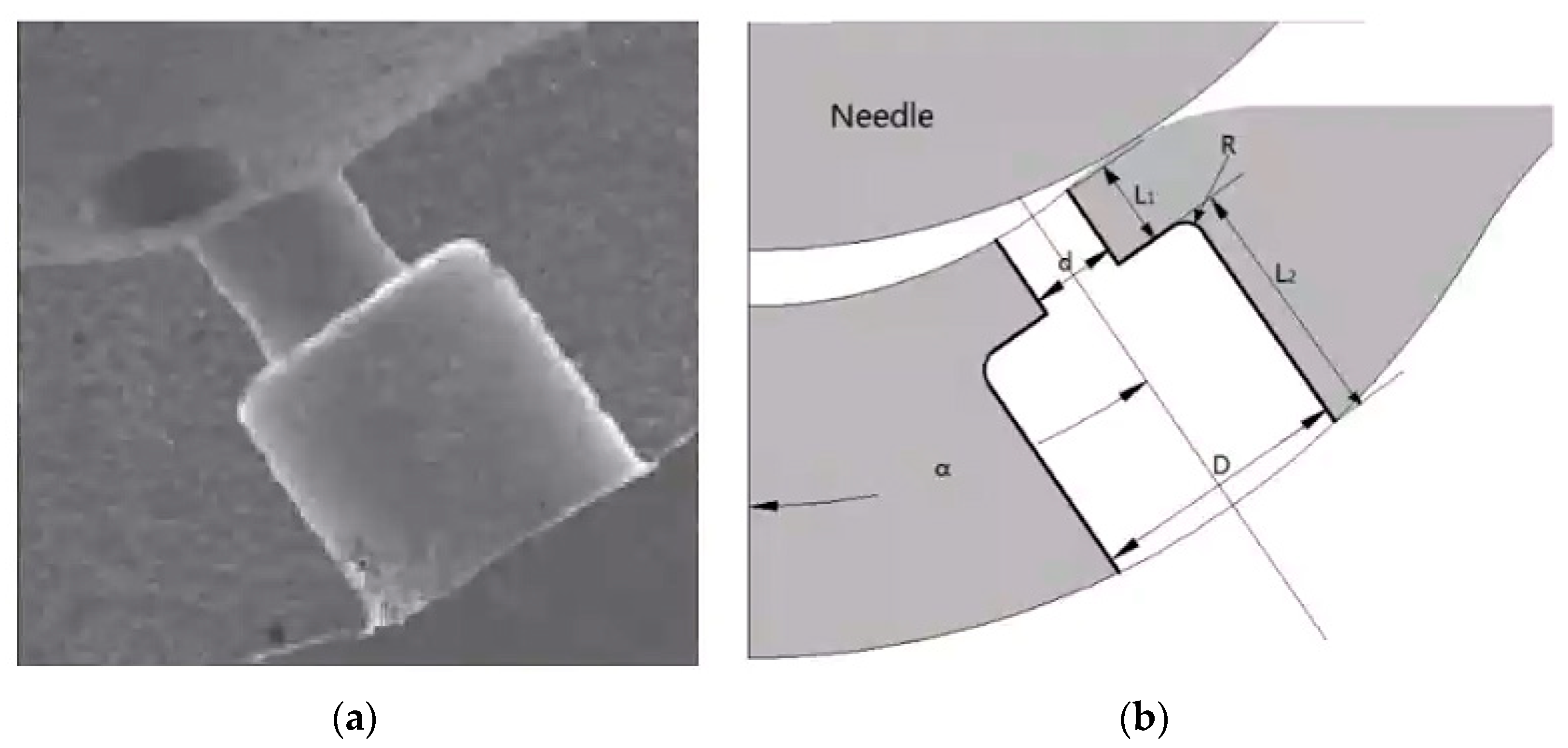


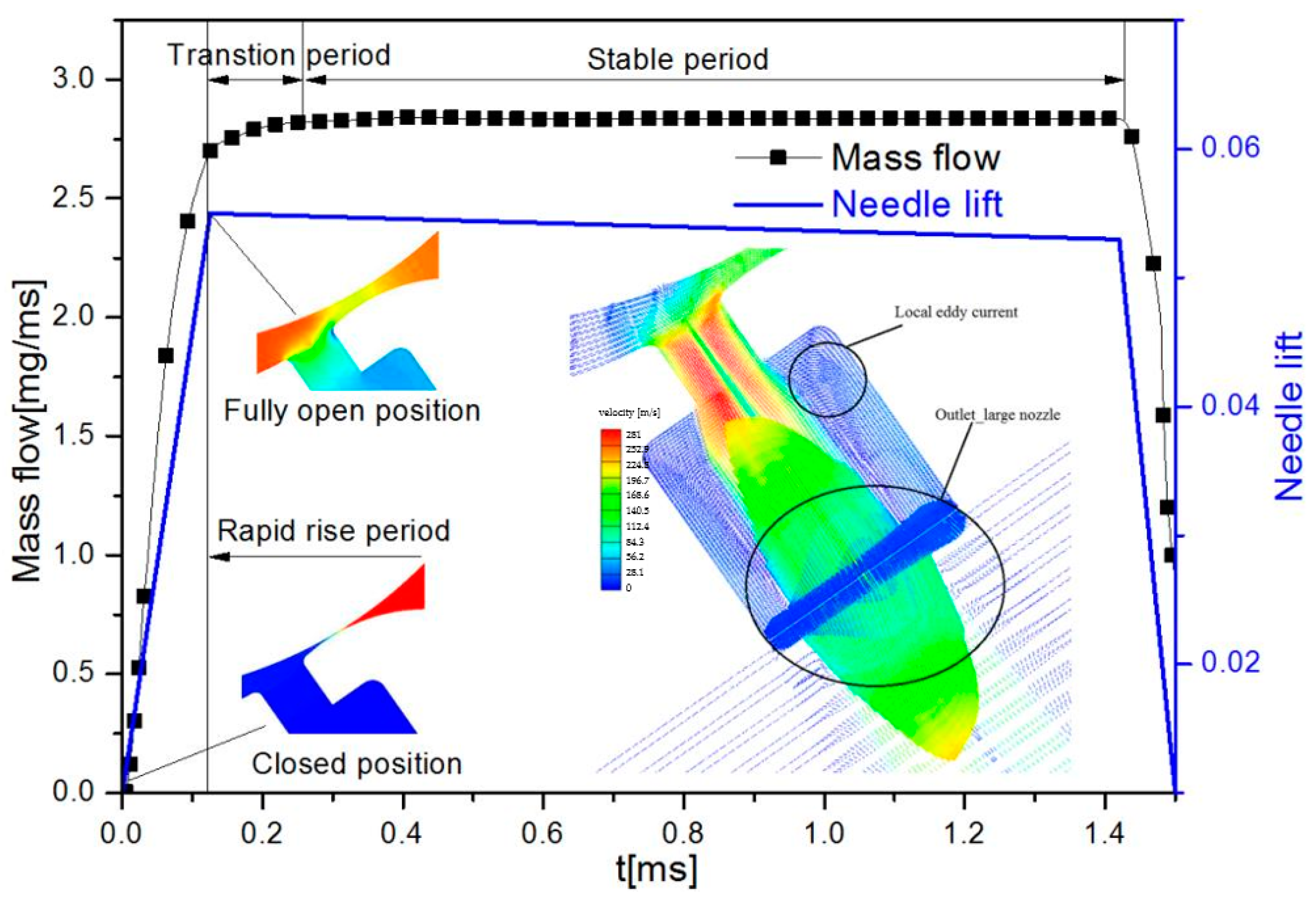

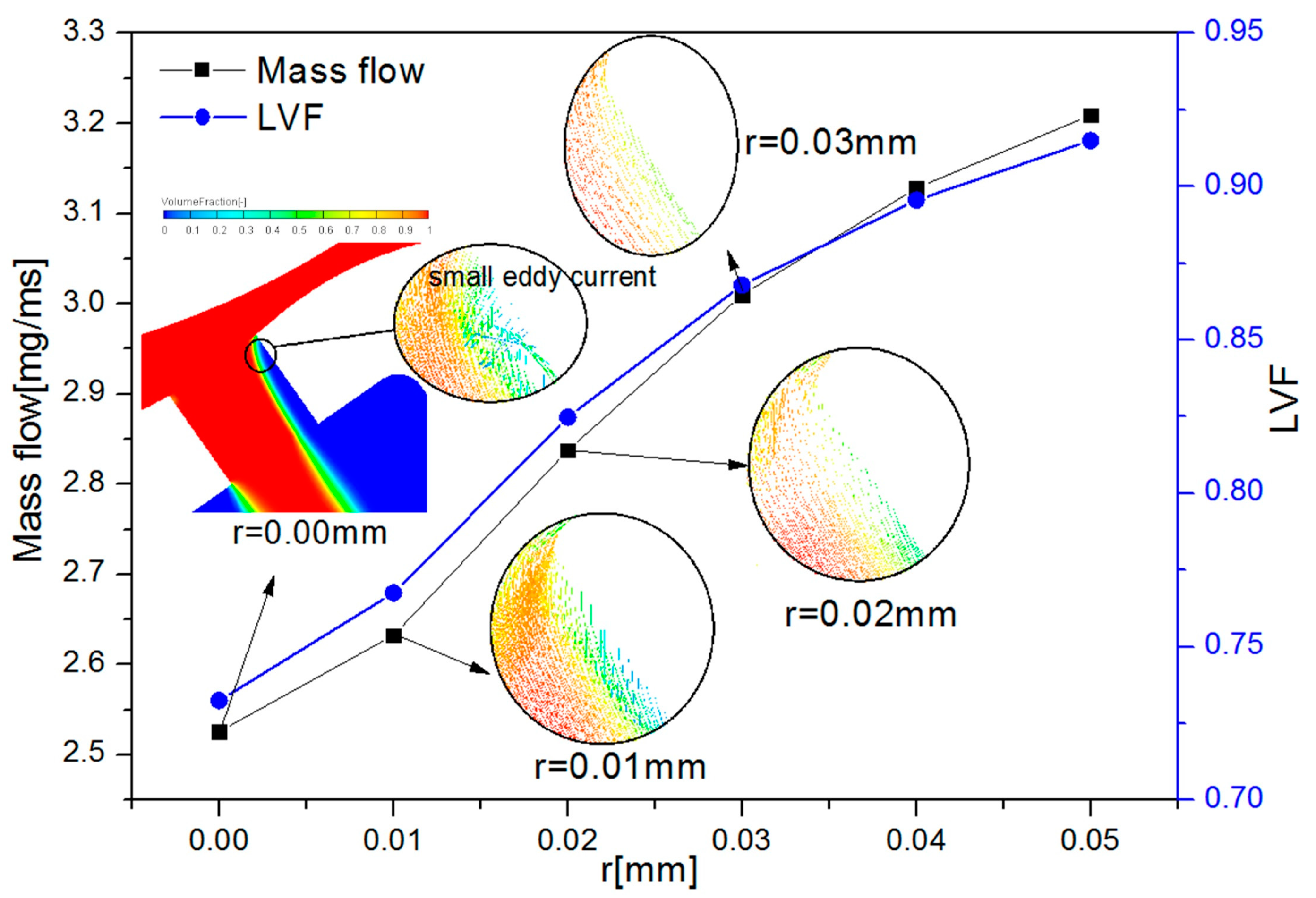
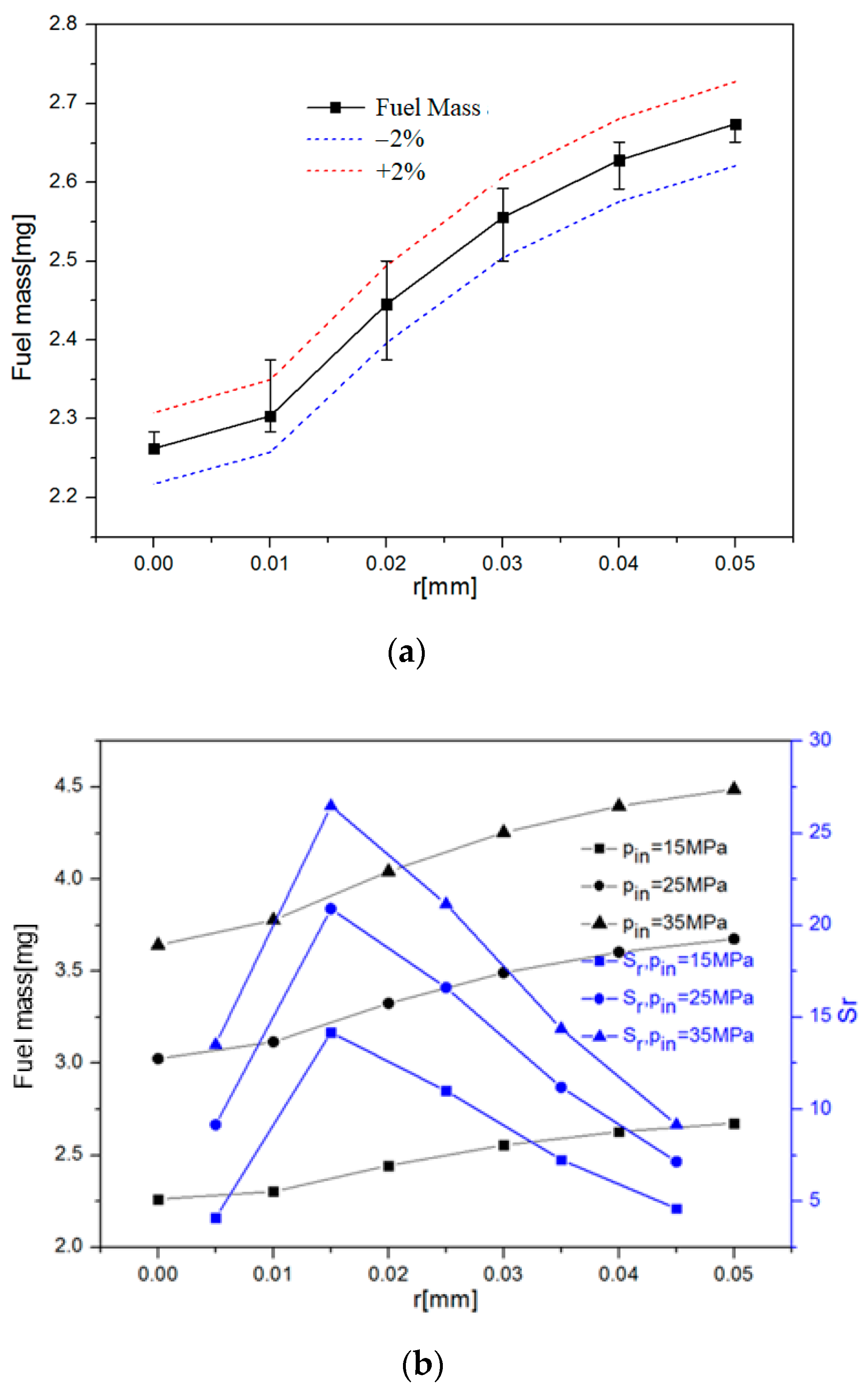



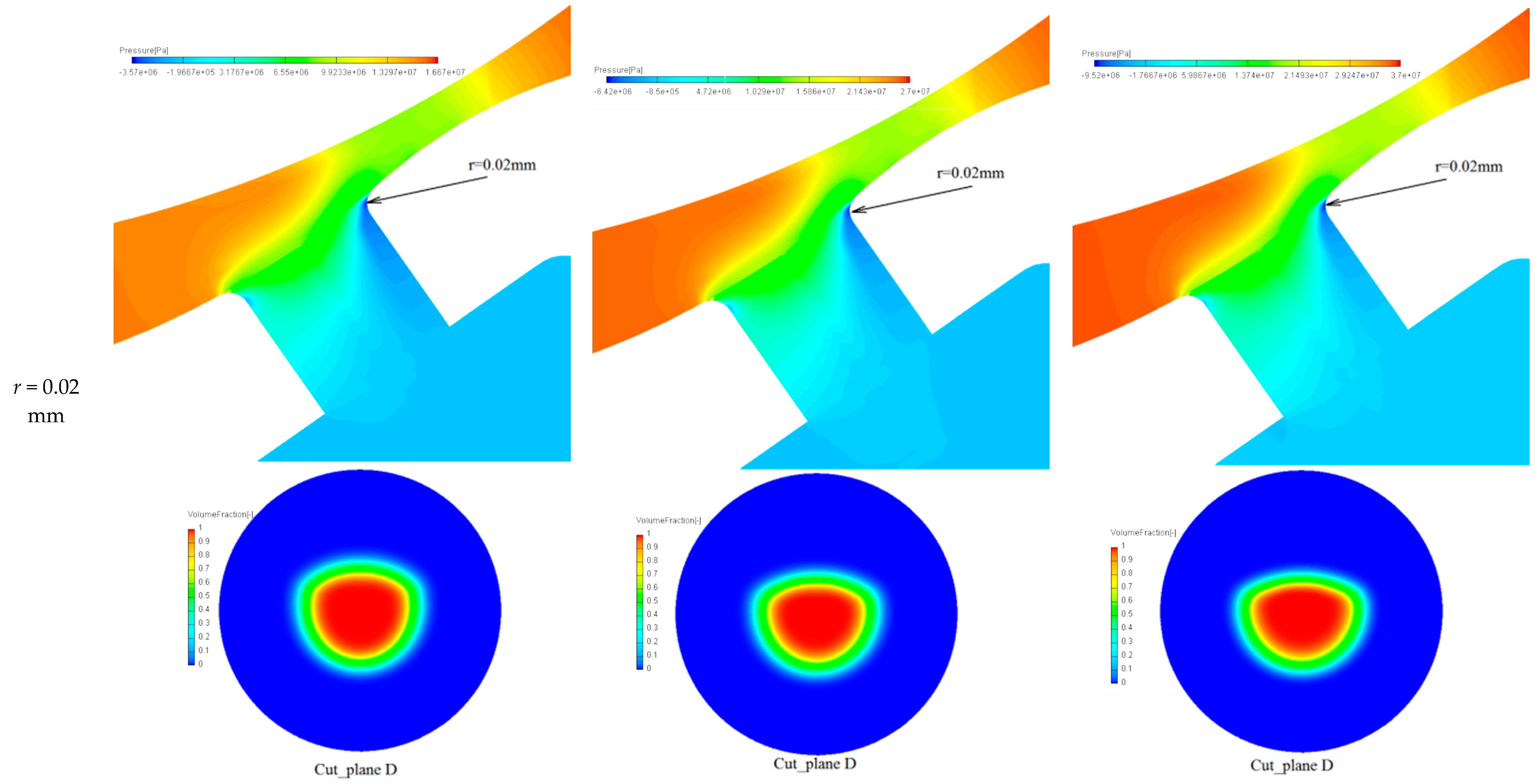

| Type | Value | Type | Value |
|---|---|---|---|
| Injector | GDI injector | Fuel | Gasoline |
| Nozzle number | 6 | Density | 0.7–0.78 kg/m3 |
| d | 0.15 mm | Dynamic viscosity | 0.76 mm2/s |
| L1 | 0.15 mm | BND_inlet | 15, 25 and 35 MPa |
| D | 0.45 mm | BND_Outlet | 0.5 MPa |
| L2 | 0.45 mm | Temperature | 293.7 K |
| R | 0.04 mm | Needle_moving | Move |
| α | 35° | Symmetry | Periodic |
Disclaimer/Publisher’s Note: The statements, opinions and data contained in all publications are solely those of the individual author(s) and contributor(s) and not of MDPI and/or the editor(s). MDPI and/or the editor(s) disclaim responsibility for any injury to people or property resulting from any ideas, methods, instructions or products referred to in the content. |
© 2024 by the authors. Licensee MDPI, Basel, Switzerland. This article is an open access article distributed under the terms and conditions of the Creative Commons Attribution (CC BY) license (https://creativecommons.org/licenses/by/4.0/).
Share and Cite
Li, X.; Guo, J.; Shen, B.; Zhang, P. Sensitivity Analysis of Injection Mass Flow to the Inlet Orifice Radius of a GDI Injector Nozzle. Processes 2024, 12, 1740. https://doi.org/10.3390/pr12081740
Li X, Guo J, Shen B, Zhang P. Sensitivity Analysis of Injection Mass Flow to the Inlet Orifice Radius of a GDI Injector Nozzle. Processes. 2024; 12(8):1740. https://doi.org/10.3390/pr12081740
Chicago/Turabian StyleLi, Xinhai, Jian Guo, Bing Shen, and Peijie Zhang. 2024. "Sensitivity Analysis of Injection Mass Flow to the Inlet Orifice Radius of a GDI Injector Nozzle" Processes 12, no. 8: 1740. https://doi.org/10.3390/pr12081740






